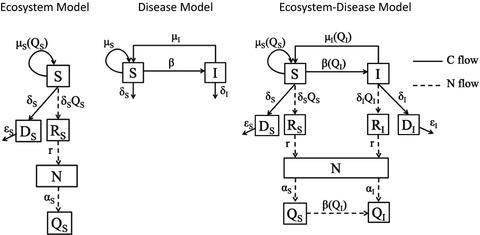当前位置:
X-MOL 学术
›
Ecol. Lett.
›
论文详情
Our official English website, www.x-mol.net, welcomes your
feedback! (Note: you will need to create a separate account there.)
Elements of disease in a changing world: modelling feedbacks between infectious disease and ecosystems
Ecology Letters ( IF 7.6 ) Pub Date : 2020-10-12 , DOI: 10.1111/ele.13617 Elizabeth T. Borer 1 , Lale Asik 2, 3 , Rebecca A. Everett 4 , Thijs Frenken 5, 6 , Angelica L. Gonzalez 7 , Rachel E. Paseka 1 , Angela Peace 2 , Eric W. Seabloom 1 , Alexander T. Strauss 1, 8 , Dedmer B. Van de Waal 5 , Lauren A. White 9
Ecology Letters ( IF 7.6 ) Pub Date : 2020-10-12 , DOI: 10.1111/ele.13617 Elizabeth T. Borer 1 , Lale Asik 2, 3 , Rebecca A. Everett 4 , Thijs Frenken 5, 6 , Angelica L. Gonzalez 7 , Rachel E. Paseka 1 , Angela Peace 2 , Eric W. Seabloom 1 , Alexander T. Strauss 1, 8 , Dedmer B. Van de Waal 5 , Lauren A. White 9
Affiliation

|
An overlooked effect of ecosystem eutrophication is the potential to alter disease dynamics in primary producers, inducing disease‐mediated feedbacks that alter net primary productivity and elemental recycling. Models in disease ecology rarely track organisms past death, yet death from infection can alter important ecosystem processes including elemental recycling rates and nutrient supply to living hosts. In contrast, models in ecosystem ecology rarely track disease dynamics, yet elemental nutrient pools (e.g. nitrogen, phosphorus) can regulate important disease processes including pathogen reproduction and transmission. Thus, both disease and ecosystem ecology stand to grow as fields by exploring questions that arise at their intersection. However, we currently lack a framework explicitly linking these disciplines. We developed a stoichiometric model using elemental currencies to track primary producer biomass (carbon) in vegetation and soil pools, and to track prevalence and the basic reproduction number (R0) of a directly transmitted pathogen. This model, parameterised for a deciduous forest, demonstrates that anthropogenic nutrient supply can interact with disease to qualitatively alter both ecosystem and disease dynamics. Using this element‐focused approach, we identify knowledge gaps and generate predictions about the impact of anthropogenic nutrient supply rates on infectious disease and feedbacks to ecosystem carbon and nutrient cycling.
中文翻译:

不断变化的世界中的疾病要素:对传染病和生态系统之间的反馈进行建模
生态系统富营养化的一个被忽视的影响是,它有可能改变初级生产者的疾病动态,引起疾病介导的反馈,从而改变初级净生产力和元素循环利用。疾病生态学中的模型很少跟踪死亡之前的生物,但是感染导致的死亡可以改变重要的生态系统过程,包括元素的循环利用率和向宿主的营养供应。相反,生态系统生态学中的模型很少跟踪疾病的动态,但是元素养分池(例如氮,磷)可以调节重要的疾病过程,包括病原体的繁殖和传播。因此,通过探索在交叉点出现的问题,疾病和生态系统生态学都将随着领域的发展而增长。但是,我们目前缺乏明确链接这些学科的框架。R 0)直接传播的病原体。该模型针对落叶林进行了参数化,证明了人为养分供应可以与疾病相互作用,从而定性地改变生态系统和疾病动态。使用这种以要素为中心的方法,我们可以识别知识差距,并就人为养分供应率对传染病的影响以及对生态系统碳和养分循环的反馈进行预测。
更新日期:2020-12-12
中文翻译:

不断变化的世界中的疾病要素:对传染病和生态系统之间的反馈进行建模
生态系统富营养化的一个被忽视的影响是,它有可能改变初级生产者的疾病动态,引起疾病介导的反馈,从而改变初级净生产力和元素循环利用。疾病生态学中的模型很少跟踪死亡之前的生物,但是感染导致的死亡可以改变重要的生态系统过程,包括元素的循环利用率和向宿主的营养供应。相反,生态系统生态学中的模型很少跟踪疾病的动态,但是元素养分池(例如氮,磷)可以调节重要的疾病过程,包括病原体的繁殖和传播。因此,通过探索在交叉点出现的问题,疾病和生态系统生态学都将随着领域的发展而增长。但是,我们目前缺乏明确链接这些学科的框架。R 0)直接传播的病原体。该模型针对落叶林进行了参数化,证明了人为养分供应可以与疾病相互作用,从而定性地改变生态系统和疾病动态。使用这种以要素为中心的方法,我们可以识别知识差距,并就人为养分供应率对传染病的影响以及对生态系统碳和养分循环的反馈进行预测。











































 京公网安备 11010802027423号
京公网安备 11010802027423号